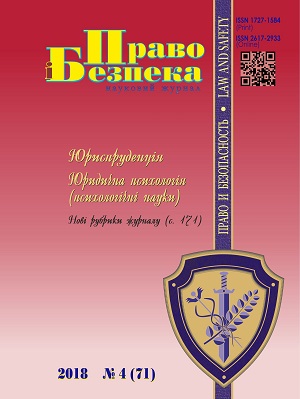Legislative power in the Republic of Poland
DOI:
https://doi.org/10.32631/pb.2018.4.02Keywords:
parliament, bicameralism, legislative power, law-making activity, regulation, representative functionAbstract
The article is focused on the problems of studying the constitutional and legal aspects of the functioning of the bicameral parliament in the Republic of Poland. The research is carried out with the aim of studying and scientific understanding of the practical implementation of certain aspects of bicameralism in Ukraine.
The peculiarities of the legal status of the Sejm and the Senate as the chambers of political representation of the sovereign Polish nation have been analyzed. It has been emphasized that certain competencies of legislative power in the Polish power system are intended to compensate for the strong positions of the executive branch, due to the assignment of the President of the Republic of Poland to it. It has been noted that in the period after the restoration of the bicameral structure of the Polish Parliament in 1989, until 2010, the Sejm held the dominant position. It has been established that at the present stage of development, the Polish constitutional doctrine foresees an asymmetric bicameral parliament model with the preservation of the system’s equivalence of chambers.
It has been noted that the result of the accession of the Republic of Poland to the European Union, the Sejm and the Senate had functional changes that covered almost all the powers of the national parliament, including, first of all, legislative and control functions, led to the appearance of elements of the “European” function of the parliament and transformed already existing commitment of both chambers.
The peculiarities of the influence of the EU legal acts on the processes of national legislation in Poland have been revealed. The directions of transformation of the normative and controlling function of the Sejm and the Senate have been determined. The principles of functional separation of powers of the Sejm and the Senate in the light of the national and European legislation have been established. It has been concluded that during the process of implementation of acts of the European law in the national legal system of the Republic of Poland, the chambers of the parliament managed to expand their powers at the expense of the so-called “European competence of the Polish parliament”.
Downloads
References
Soroka S.V., 2015. Senate in the system of state power’s bodies in Poland in 1989-2009 [Senat u systemi orhaniv derzavnoi vlady Respubliky Polshcha v 1989-2009 rokakh]. Naukovì pracì. Serìâ: Deržavne upravlìnnâ – Scientific works. Series: State management, Vol. 263, Iss. 252, pp. 130-136.
Grobova V.P., 2010. Bikameralizm: Republic Poland Experience [Bikameralizm: dosvid Respubliky Polshcha]. Forum prava – Forum of law, [online] No. 2, pp. 105-110. Available at http://nbuv.gov.ua/j-pdf/FP_index.htm_2010_2_20.pdf [Accessed 09 December 2018].
Kukuruz O., 2008. Parliamentary majority and opposition in the Sejm of the Republic of Poland [Parlamentska bilshist ta opozytsiia v Seimi Respubliky Polshcha]. Polìtičnij menedžment – Political Management, No. 6, pp. 79-89.
Nechyporenko Yu., 2013. Political structure of the Parliament of the Republic of Poland under the influence of the electoral system [Politychne strukturuvannia parlamentu Respubliky Polshcha pid vplyvom vyborchoi systemy]. Gileya: scientific herald, No. 73, pp. 354-355.
Popovych T.P., 2015. Change content of the highest state authority in the Polish Republic (late 1980s – 1990s) [Zmina zmistu orhanizatsii derzavnoi vlady v Polskii Respublitsi (kinets 1980-kh – 1990-ti roky]. Naukovij vìsnik Užgorodsʹkogo nacìonalʹnogo unìversitetu. Serìâ Pravo – Uzhhorod National University Herald. Series: Law, Iss. 35, pp. 59-63.
Sarnecki P., 2013. Prawo konstytucyjne Rzeczypospolitej Polskiej. Warszawa: Wydawnictwo C.H.Beck.
Dobrowolski M., 2005. Zasada dwuizbowości parlamentu w polskim prawie konstytucyjnym. Warszawa: Wydawnictwo Sejmowe.
Bisztyga A., Zientarski P. (red. nauk.), 2014. Kierunki zmian pozycji ustrojowej i funkcji Senatu RP. Warszawa: Kanc. Senatu.
Skrzydło W., 2010. Polskie prawo konstytucyjne. Wyd. 6. Lublin: Verba.
Dobrowolski M., 2000. Dwuizbowość parlamentu jako zasada Konstytucji RP. Państwo i Prawo, nr 4, ss. 47-53.
Sarnecki P., 2007. Problem dwuizbowości parlamentu. W: Granat M. (red.). Zagadnienia prawa parlamentarnego: Materiały z XLVII Ogólnopolskiego Zjazdu Katedr i Zakładów Prawa Konstytucyjnego. Serock 1-3 czerwca 2006 r. Warszawa: Wydawnictwo Sejmowe. Ss. 142-143.
Dobrowolski M., 2005. Zasada dwuizbowości parlamentu w polskim prawie konstytucyjnym. Warszawa: Wydawnictwo Sejmowe.
Soroka S., 2010. Mechanisms of cooperation of the Senate of Republic of Poland with the Sejm in the process of legislative function realization [Mekhanizmy vzaiemodii Senatu Respubliky Polshcha z Seimom u protsesi realizatsii zakonodavchoi funktsii]. Deržavne upravlìnnâ ta mìsceve samovrâduvannâ – Public administration and local government, [online] Iss. 3. Available at http://www.dridu.dp.ua/vidavnictvo/2010/2010_03(6)/10ssvrzf.pdf [Accessed 09 December 2018].
Czarny P., Kulig A., Naleziński B., Sarnecki P., Tuleja P. i Wojtyczek K., 2011. Prawo konstytucyjne Rzeczypospolitej Polskiej. Warszawa: Wydawnictwo C.H.Beck. (Pod red.: Sarnecki P.).
Szymanek J., 2007. Pozalegislacyjne funkcje i kompetencje drugich izb parlamentarnych. W: Granat M. (red.). Zagadnienia prawa parlamentarnego. Warszawa: Wydawnictwo Sejmowe. Ss. 297-317.
Górniewicz E., 2009. Wzmocnienie roli parlamentów narodowych w konstrukcji europejskiej. Biuro analiz, nr 23, ss. 1-2.
Popławska E., 2010. Rola parlamentów narodowych w świetle traktatu z Lizbony. Przegląd Sejmowy, nr 5, ss. 157-174.
Lis-Staranowicz D., 2007. Komisja śledcza i Komisja ds. Unii Europejskiej w systemie organów Sejmu. W: Granat M. (red.). Zagadnienia prawa parlamentarnego. Warszawa: Wydawnictwo Sejmowe. S. 231-253.
Szymanek J., 2005. „Funkcja europejska” Sejmu i Senatu jako ustrojowy efekt członkostwa w Unii Europejskiej. W: Kruk M. i Wawrzyniak J. (red.). Polska w Unii Europejskiej. Krakow: Kantor Wydawniczy Zakamycze; Grupa Wolters Kluwer. Ss. 347-364.
Marszałek-Kawa J., 2012. Pozycja ustrojowa i funkcje Sejmu Rzeczypospolitej Polskiej po akcesji do Unii Europejskiej. Warszawa: ELIPSA.
Sarnecki P., 2004. Wspołpraca Rаdy Ministrow z Sejmem i Senatem przy wykonywaniu przez Polskę praw członkowskich w UE. Przegląd Sejmowy, nr 5, ss. 13-15.



